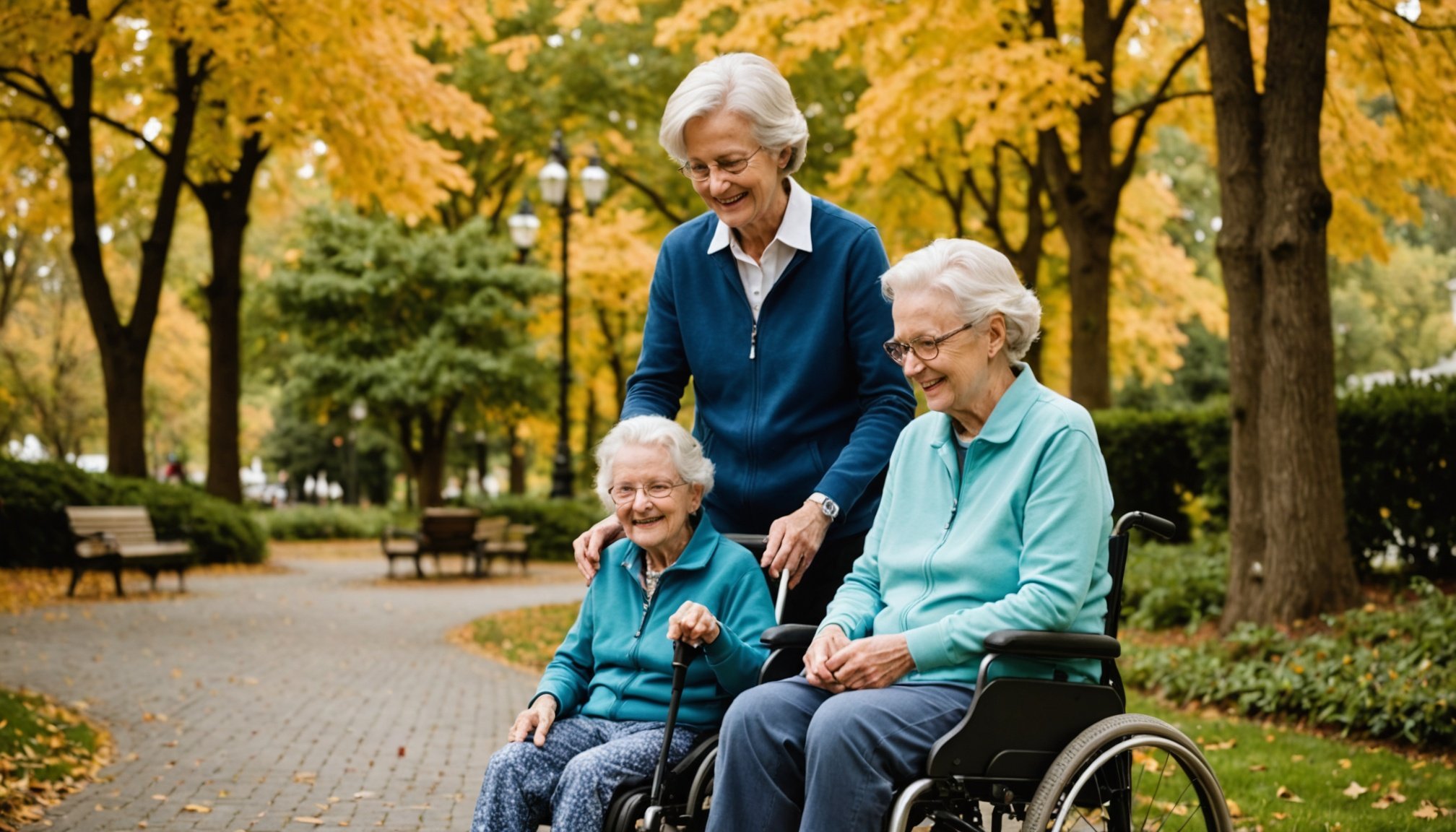Understanding Adaptive Clothing
Adaptive clothing for seniors is designed specifically to meet the unique needs of individuals who have difficulty with conventional apparel. Unlike traditional clothing, which often features buttons, zips, and other fastenings that can be cumbersome for individuals with limited mobility, adaptive clothing offers solutions like Velcro closures, magnets, and easy-to-open designs to promote independence and comfort.
One of the significant benefits of adaptive clothing is that it enhances the overall quality of life for seniors. By simplifying the process of getting dressed, these garments empower seniors to maintain their dignity and autonomy. Adaptive designs can also accommodate medical devices, such as feeding tubes or catheters, without compromising on style or functionality.
Topic to read : How can older adults safely manage chronic pain without relying on medication?
Moreover, adaptive clothing is not only practical but also focuses on aesthetics, ensuring that seniors do not have to sacrifice their personal style. This emphasis on style is crucial in fostering a sense of normalcy and confidence in their everyday lives.
In summary, adaptive clothing offers a profound difference by catering to the specific needs of seniors, leading to greater comfort and ease while maintaining a sense of dignity and independence.
Also to discover : Empowering Generations: How Grandparents Can Boost Child Development While Prioritizing Their Health
Key Features for Comfort
Choosing the right fabrics in adaptive clothing is paramount for ensuring comfort, especially for seniors who often have heightened sensitivity. Comfortable fabrics are essential because they directly touch the skin and can influence general well-being.
Importance of Fabric Type
The type of fabric used in clothing can greatly impact its comfort level. Soft materials, like cotton and microfiber, offer gentle contact with the skin, reducing irritation and promoting ease of movement. They are a go-to choice for those looking to combine comfort with practicality.
Characteristics of Soft and Breathable Materials
Breathable clothing is crucial in maintaining a comfortable body temperature. Fabrics like bamboo and merino wool excel at wicking moisture away from the skin, keeping the wearer dry and comfortable. Additionally, their lightweight nature allows for unrestricted movement.
Examples of Comfortable Fabrics
Several fabrics stand out in the realm of adaptive clothing due to their comfort and adaptability:
- Cotton: Known for its softness and breathability.
- Bamboo: Offers natural antibacterial properties and outstanding breathability.
- Microfiber: Lightweight and soft, excellent for sensitive skin.
These materials together ensure that adaptive clothing not only fits well but also supports the health and comfort of its wearer.
Ease of Dressing
Adaptive clothing has revolutionised the way seniors dress, emphasising ease and comfort. These garments feature easy-to-wear clothing options like magnetic buttons and Velcro fastenings, replacing traditional buttons and zippers. Such designs not only reduce the effort required but also maintain style and elegance.
Dressing aids complement these garments by offering practical tools designed to assist seniors in everyday dressing tasks. Sock aids and button hooks are popular choices, enabling individuals with limited mobility to continue dressing independently.
Adaptive design principles are at the heart of these innovations. They aim to simplify the dressing process by integrating technologies that accommodate physical limitations. This includes features like elastic waistbands, back-closure garments, and wider neck openings, ensuring that personal dressing remains a straightforward and dignified experience.
Together, these clothes and aids create a harmonious balance between function and style, ensuring that seniors can comfortably manage their dressing routines with minimal assistance.
Adjustability in Clothing
Adjustable Clothing is paramount, especially in adaptive attire, offering a bespoke fit tailored to individual needs. This flexibility enhances comfort and practicality for various life stages, notably for seniors who may encounter fluctuating body shapes.
The essence of adjustability lies in the myriad of modifications available—such as adjustable straps, elastic bands, and Velcro attachments. These features permit a custom fit that accommodates changes in body size or ease in dressing. This adaptability is crucial for individuals with dexterity challenges, ensuring they can maintain independence.
Adopting adjustable clothing facilitates better mobility and prevents the discomfort associated with poorly fitting garments. Benefits of a customizable fit extend beyond mere fashion; they impact the wearer’s well-being by minimizing pressure points and allowing for easier movement. Anecdotal evidence suggests that seniors value the flexibility and ease presented by these garments, thus significantly enhancing their daily experiences.
In creating an inclusive wardrobe, focus on pieces with versatile attributes that cater to diverse needs. Adjustable clothing merges style with functionality, ensuring that individuals feel both confident and comfortable, regardless of physical changes over time. Adjustability offers timeless appeal, combining fashion with adaptability.
Sensory Considerations
Understanding sensory sensitivities in older adults is crucial, particularly when considering clothing choices. Sensitivity management is essential as aging can amplify discomfort caused by certain textures, seams, or tags in clothing. Elder adults often experience increased tactile sensitivity, making traditional clothing uncomfortable or even painful.
Sensory-friendly clothing offers a practical solution, designed with the comfort needs in mind. Features such as flat or minimal seams, tagless designs, and soft, breathable fabrics are at the forefront of sensory-friendly options. These adaptations aim to minimise irritation and provide a calming and soothing experience for the wearer, promoting well-being and ease of movement.
The importance of sensory-friendly options in adaptive clothing cannot be overstated. They support the independence and dignity of individuals, addressing their specific comfort requirements without compromising on style. Such garments not only fulfill the aesthetic preferences but also significantly improve the quality of life by aligning with personal comfort standards.
Ultimately, selecting clothing that meets comfort needs proactively supports the health and happiness of older adults, empowering them to engage confidently in daily activities without the stress or discomfort associated with traditional clothing choices.
Durability and Care
For seniors, durable clothing is essential. It ensures longevity and meets the demand for everyday comfort and safety. The importance of durability lies not just in the lifespan of the clothing but also in its ability to withstand frequent washing and wear.
Taking care of this specialized clothing involves understanding its unique materials and needs. Recommendations include:
- Washing with mild detergent to avoid fabric degradation
- Air drying when possible to preserve elasticity and fit
- Regular checks for wear and tear, ensuring zippers and fasteners function properly
Examples of materials known for their durability include cotton blends, polyester, and spandex. These materials provide a balance of comfort and strength, crucial for seniors needing reliable daily wear.
Additionally, easy-to-clean fabrics significantly reduce maintenance hassle and expense, making them ideal for those seeking practicality in their wardrobes.
Ultimately, selecting durable clothing is a practical choice that combines convenience with an extended lifespan, ensuring seniors can enjoy their garments without frequent replacements.
Style Options Available
Adaptive clothing has modernised remarkably, bringing a fashionable flair to garments designed for seniors. Fashion for Seniors is no longer a compromise between comfort and style—it’s a fusion that boosts self-esteem and independence. Stylish Adaptive Clothing has stepped up, showing that practicality doesn’t mean sacrificing fashion.
Several innovative brands are leading this style revolution. Companies like Silverts and Buck & Buck focus on Modern Adaptive Wear, creating chic designs that can be worn with dignity and ease. They incorporate magnetic closures and easy-to-manage fastenings, meeting both functional and aesthetic needs.
These fashion-forward adaptations are about more than just looks. They serve as crucial tools for enhancing the quality of life, offering seniors a sense of empowerment and individuality. Instead of feeling constrained by traditional adaptive wear, seniors can select from a variety of modern styles. This availability encourages seniors not only to dress according to their personal taste but also to engage more confidently in social activities.
Adopting these style options supports a positive mindset and underscores the importance of seeing adaptive clothing through the lens of fashion for all ages.
Tips for Purchasing Adaptive Clothing
Choosing the right adaptive clothing can significantly improve daily comfort and ease. When buying adaptive clothing, consider factors such as ease of wear, material, and functionality. Fabrics should be soft and breathable to prevent skin irritation, and the design should facilitate easy dressing, especially for individuals with motor challenges.
When it comes to shopping tips, explore brands that specialise in adaptive wear. Major retailers in the clothing industry now provide sections dedicated to adaptive clothing, ensuring a wide range of styles and functions tailored to various needs. Always assess the accessibility features they advertise, such as magnetic closures or side-openings.
Considerations regarding sizing and fit are crucial for comfort. Adaptive clothing may fit differently than standard options. Therefore, it’s advisable to consult sizing guides specific to each brand. Prioritise garments that allow for easy adjustments, ensuring they accommodate any assistive devices or body changes.
In summary, thoughtful buying adaptive clothing involves understanding individual needs, exploring reputable retailers and ensuring perfect sizing. These steps lead to more practical and comfortable daily wear.
Recommended Brands and Products
When searching for the best adaptive clothing brands, several options stand out for their innovation and quality. Popular brands like Silverts, Tommy Adaptive, and Izzy Camilleri have gained recognition for their commitment to inclusivity and style. Each brings unique features to the table, making them leaders in the adaptive clothing market.
Silverts excels in creating garments with features like magnetic closures and side-opening pants, simplifying the dressing process for individuals with limited mobility. Users praise their practicality and affordability, often noting they make daily routines much smoother.
Tommy Adaptive offers a stylish twist, seamlessly blending fashion with function. Its line includes magnetic zippers and adjustable hems, catering to a diverse audience that values both aesthetics and convenience. According to reviews, wearers appreciate the modern look and accessibility these clothes provide.
Izzy Camilleri’s collection is noted for customisable designs that focus on wheelchair users. The brand’s efficient use of materials and purposeful tailoring have received accolades for comfort and fit, showing their awareness of special needs.
These brands, through innovative products, are reshaping the landscape of adaptive clothing, demonstrating that style and accessibility can go hand in hand. User experiences further validate the effectiveness and necessity of these thoughtful designs.
Where to Buy Adaptive Clothing
Searching for adaptive clothing can be an empowering experience, especially with various options available through both online and local retailers. Online shopping provides a convenient and inclusive platform for exploring a vast array of adaptive clothing choices. Websites dedicated to adaptive clothing often feature comprehensive collections that cater to specific needs, offering filters for size, disability type, and clothing style. This is ideal for those seeking specific features like magnetic closures or side openings.
On the other hand, local stores might also offer adaptive clothing options, but finding them requires some detective work. Visiting larger department stores or specialty shops with a focus on inclusivity can yield surprising finds. Local stores can provide an opportunity to feel the fabric and assess the functionality in person, but availability may be limited. It helps to call ahead or visit store websites to check their stock.
The benefits of shopping online include greater variety and the ability to compare prices easily. Many online retailers provide customer reviews, giving insight into the fit and function of the clothing. Opting for reputable retailers for adaptive clothing can save time and ensure a satisfactory shopping experience.

